Abstract
Conspiracy beliefs about HIV/AIDS have been endorsed by significant percentages of African Americans in prior research. However, almost no research has investigated the relationship of such beliefs to behaviors and attitudes relevant to HIV risk. In the present exploratory study, 71 African-American adults (aged 18-45; 61% female) in the United States participated in a national, cross-sectional telephone survey examining the relationship of HIV/AIDS conspiracy beliefs to sexual attitudes and behaviors. Results indicated significant associations between endorsement of a general HIV/AIDS government conspiracy and negative beliefs regarding condoms and greater numbers of sexual partners. Endorsement of HIV/AIDS treatment conspiracies was related to positive attitudes about condoms and greater condom use intentions. Findings suggest that conspiracy beliefs have implications for HIV prevention in African-American communities.
Full text
PDF
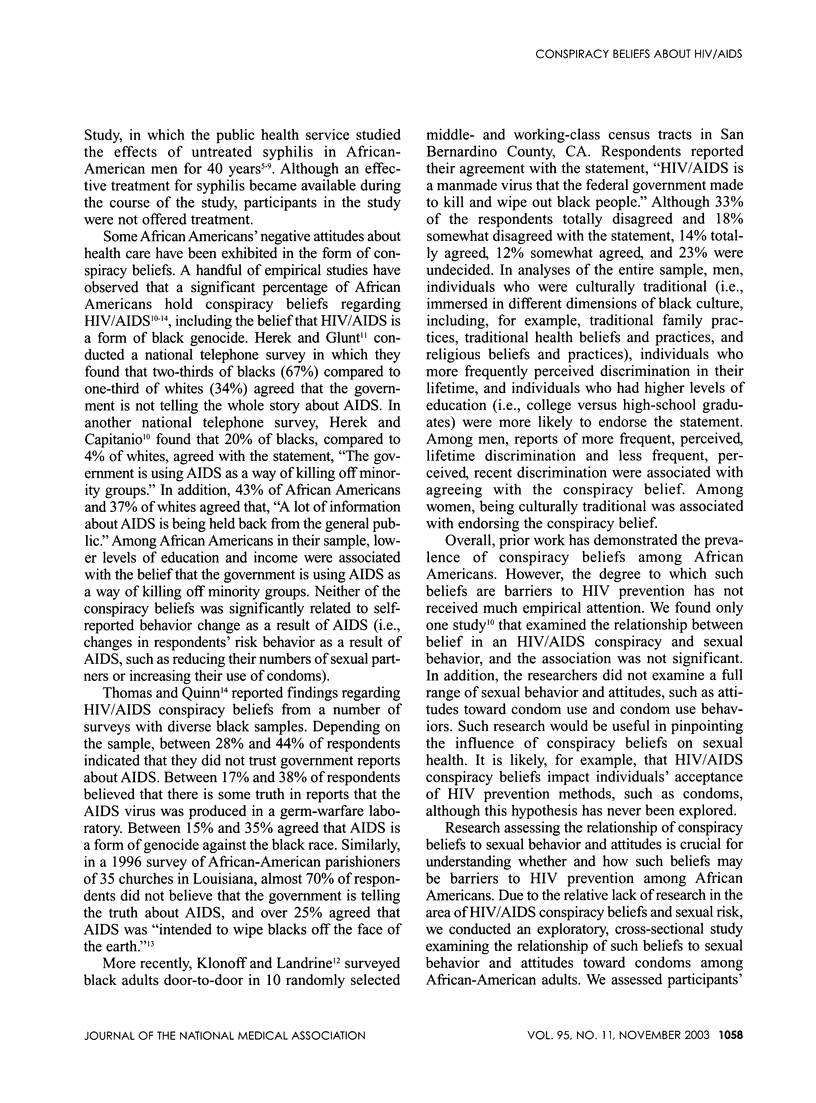
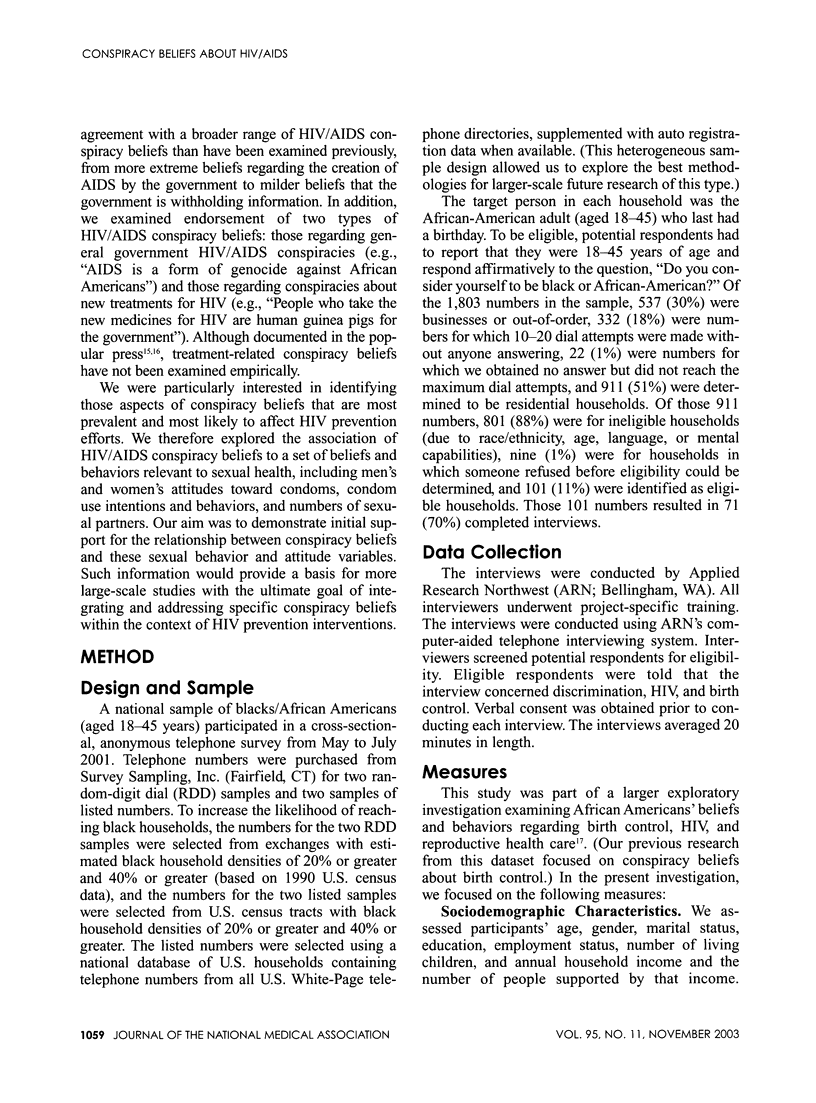
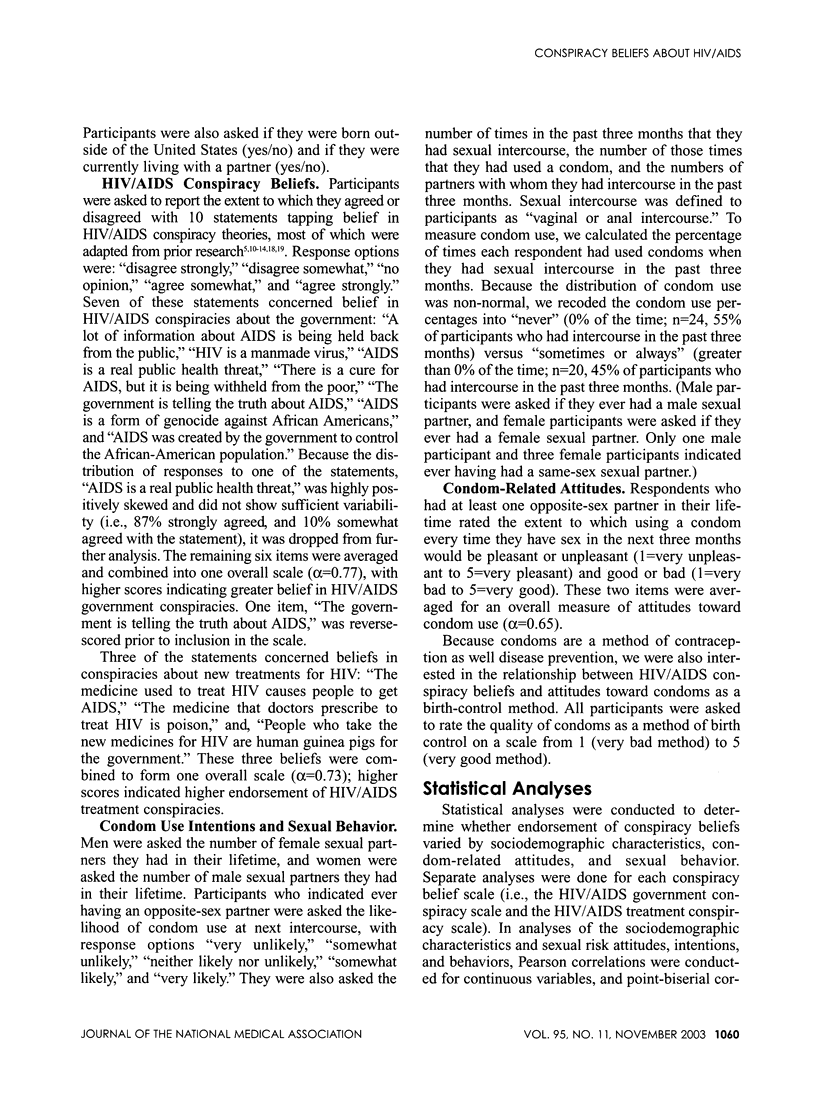
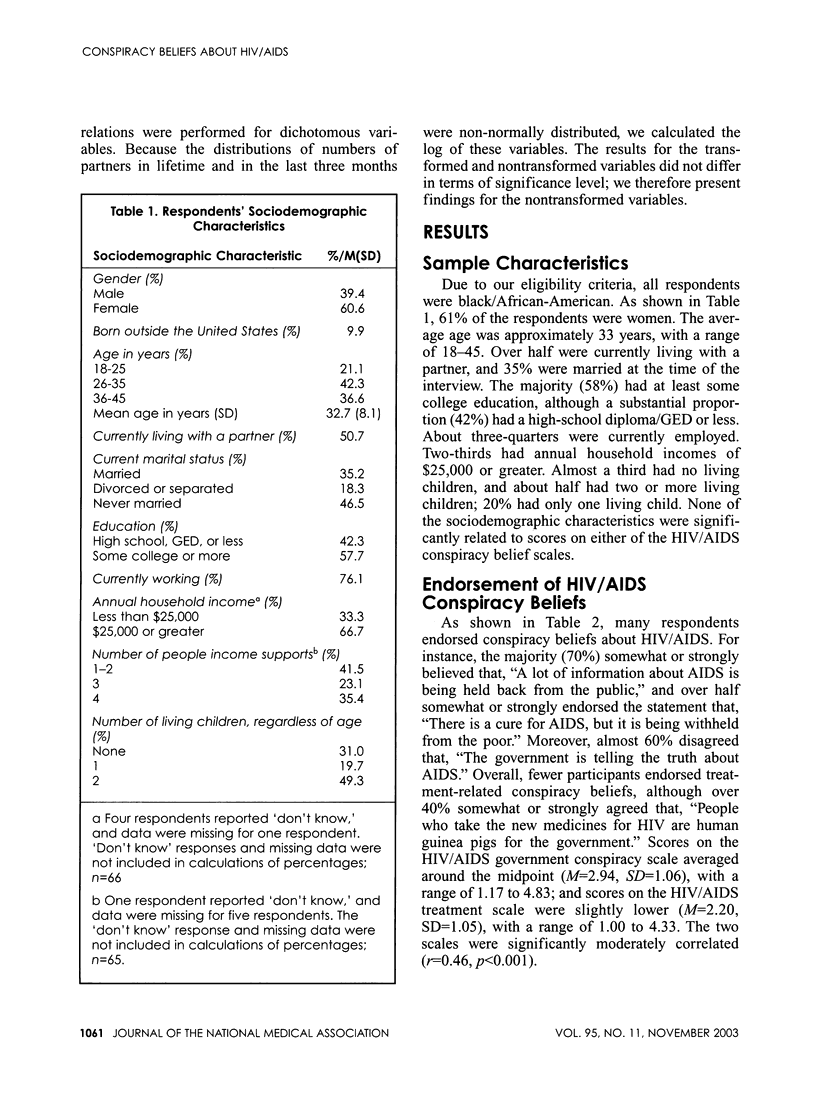
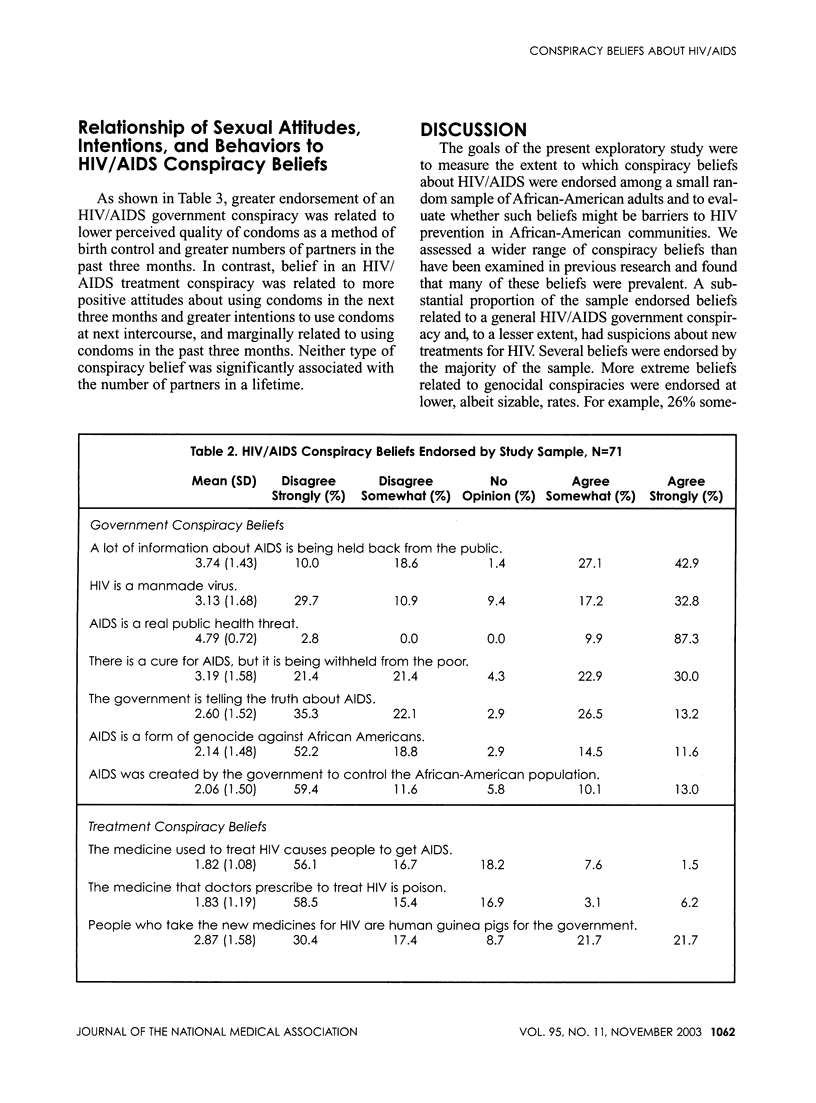

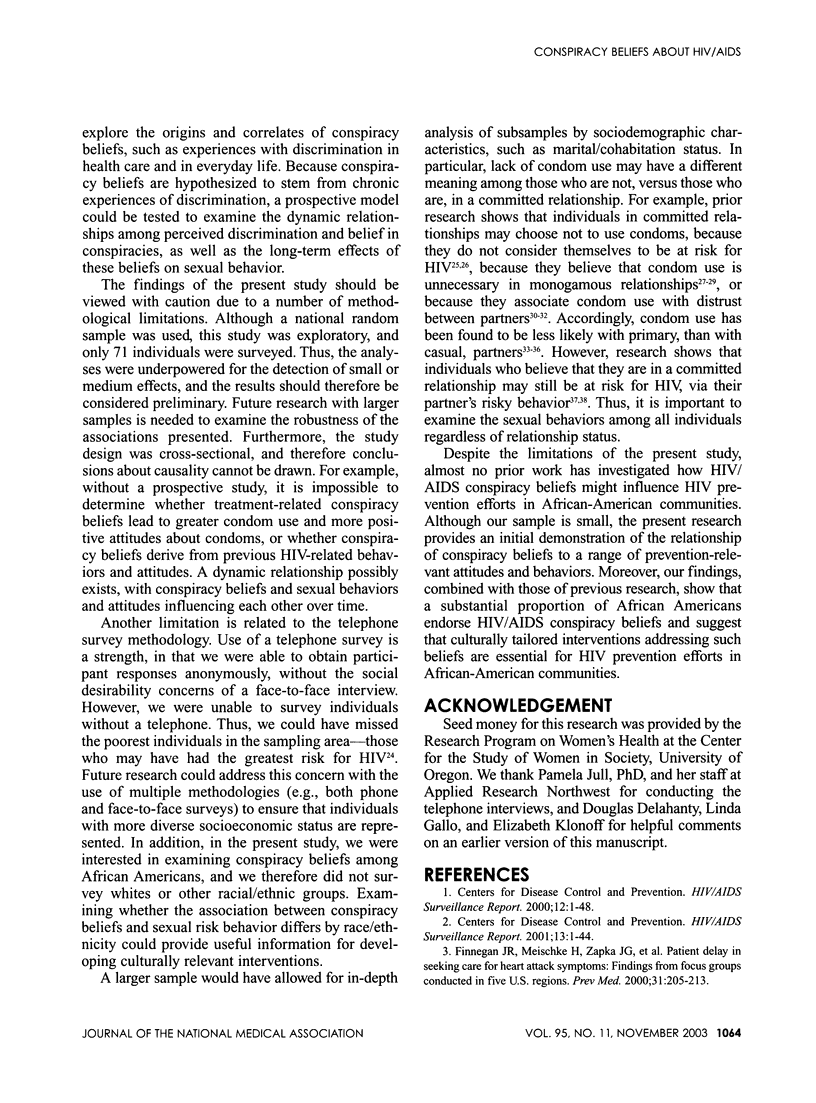
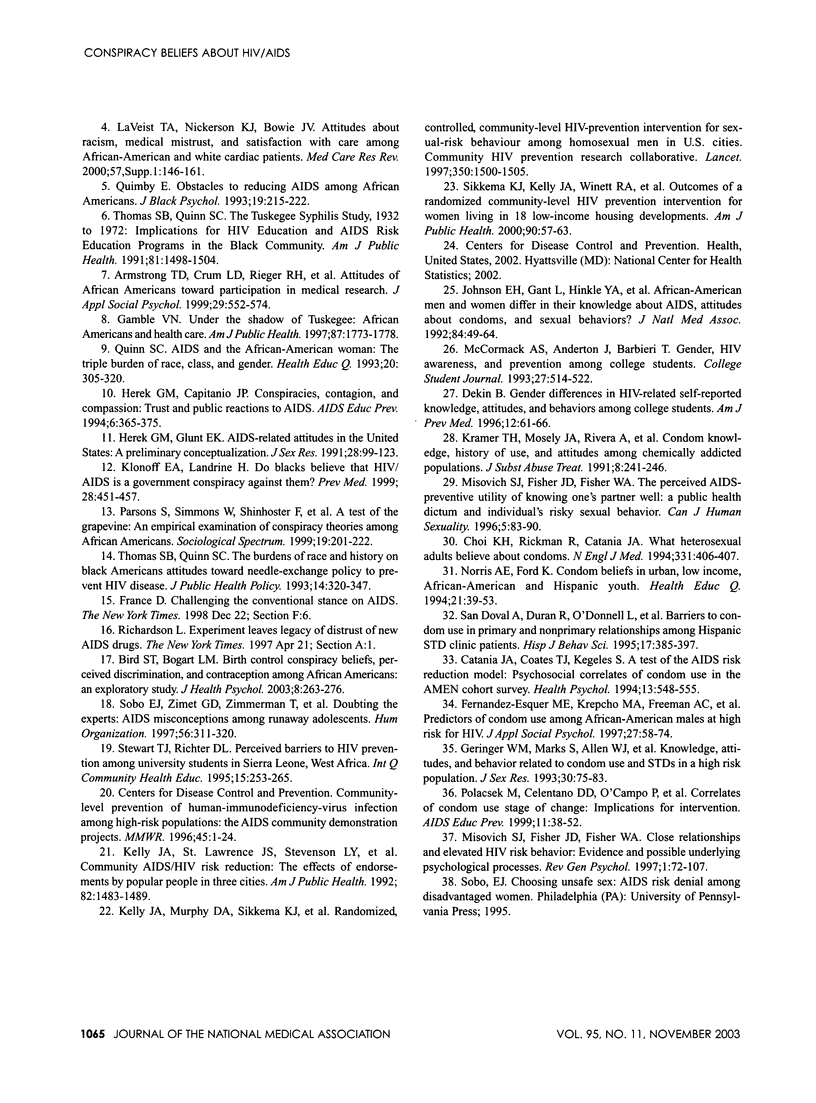
Selected References
These references are in PubMed. This may not be the complete list of references from this article.
- Catania J. A., Coates T. J., Kegeles S. A test of the AIDS risk reduction model: psychosocial correlates of condom use in the AMEN cohort survey. Health Psychol. 1994 Nov;13(6):548–555. doi: 10.1037//0278-6133.13.6.548. [DOI] [PubMed] [Google Scholar]
- Choi K. H., Rickman R., Catania J. A. What heterosexual adults believe about condoms. N Engl J Med. 1994 Aug 11;331(6):406–407. doi: 10.1056/NEJM199408113310619. [DOI] [PubMed] [Google Scholar]
- Dekin B. Gender differences in HIV-related self-reported knowledge, attitudes, and behaviors among college students. Am J Prev Med. 1996 Jul-Aug;12(4 Suppl):61–66. [PubMed] [Google Scholar]
- Doval A. S., Duran R., O'donnell L., O'donnell C. R. Barriers to condom use in primary and nonprimary relationships among Hispanic STD clinic patients. Hisp J Behav Sci. 1995 Aug;17(3):385–397. doi: 10.1177/07399863950173008. [DOI] [PubMed] [Google Scholar]
- Finnegan J. R., Jr, Meischke H., Zapka J. G., Leviton L., Meshack A., Benjamin-Garner R., Estabrook B., Hall N. J., Schaeffer S., Smith C. Patient delay in seeking care for heart attack symptoms: findings from focus groups conducted in five U.S. regions. Prev Med. 2000 Sep;31(3):205–213. doi: 10.1006/pmed.2000.0702. [DOI] [PubMed] [Google Scholar]
- Gamble V. N. Under the shadow of Tuskegee: African Americans and health care. Am J Public Health. 1997 Nov;87(11):1773–1778. doi: 10.2105/ajph.87.11.1773. [DOI] [PMC free article] [PubMed] [Google Scholar]
- Herek G. M., Capitanio J. P. Conspiracies, contagion, and compassion: trust and public reactions to AIDS. AIDS Educ Prev. 1994 Aug;6(4):365–375. [PubMed] [Google Scholar]
- Johnson E. H., Gant L., Hinkle Y. A., Gilbert D., Willis C., Hoopwood T. Do African-American men and women differ in their knowledge about AIDS, attitudes about condoms, and sexual behaviors? J Natl Med Assoc. 1992 Jan;84(1):49–64. [PMC free article] [PubMed] [Google Scholar]
- Kelly J. A., Murphy D. A., Sikkema K. J., McAuliffe T. L., Roffman R. A., Solomon L. J., Winett R. A., Kalichman S. C. Randomised, controlled, community-level HIV-prevention intervention for sexual-risk behaviour among homosexual men in US cities. Community HIV Prevention Research Collaborative. Lancet. 1997 Nov 22;350(9090):1500–1505. doi: 10.1016/s0140-6736(97)07439-4. [DOI] [PubMed] [Google Scholar]
- Kelly J. A., St Lawrence J. S., Stevenson L. Y., Hauth A. C., Kalichman S. C., Diaz Y. E., Brasfield T. L., Koob J. J., Morgan M. G. Community AIDS/HIV risk reduction: the effects of endorsements by popular people in three cities. Am J Public Health. 1992 Nov;82(11):1483–1489. doi: 10.2105/ajph.82.11.1483. [DOI] [PMC free article] [PubMed] [Google Scholar]
- Klonoff E. A., Landrine H. Do blacks believe that HIV/AIDS is a government conspiracy against them? Prev Med. 1999 May;28(5):451–457. doi: 10.1006/pmed.1999.0463. [DOI] [PubMed] [Google Scholar]
- Kramer T. H., Mosely J. A., Rivera A., Ottomanelli G., Li P. W., Bihari B. Condom knowledge, history of use, and attitudes among chemically addicted populations. J Subst Abuse Treat. 1991;8(4):241–246. doi: 10.1016/0740-5472(91)90045-c. [DOI] [PubMed] [Google Scholar]
- LaVeist T. A., Nickerson K. J., Bowie J. V. Attitudes about racism, medical mistrust, and satisfaction with care among African American and white cardiac patients. Med Care Res Rev. 2000;57 (Suppl 1):146–161. doi: 10.1177/1077558700057001S07. [DOI] [PubMed] [Google Scholar]
- Norris A. E., Ford K. Condom beliefs in urban, low income, African American and Hispanic youth. Health Educ Q. 1994 Spring;21(1):39–53. doi: 10.1177/109019819402100106. [DOI] [PubMed] [Google Scholar]
- Polacsek M., Celentano D. D., O'Campo P., Santelli J. Correlates of condom use stage of change: implications for intervention. AIDS Educ Prev. 1999 Feb;11(1):38–52. [PubMed] [Google Scholar]
- Quinn S. C. AIDS and the African American woman: the triple burden of race, class, and gender. Health Educ Q. 1993 Fall;20(3):305–326. doi: 10.1177/109019819302000303. [DOI] [PubMed] [Google Scholar]
- Richter D. Existentialism and postmodernism. Continuities, breaks, and some consequences for medical theory. Theor Med. 1994;15(3):253–265. doi: 10.1007/BF01313341. [DOI] [PubMed] [Google Scholar]
- Sikkema K. J., Kelly J. A., Winett R. A., Solomon L. J., Cargill V. A., Roffman R. A., McAuliffe T. L., Heckman T. G., Anderson E. A., Wagstaff D. A. Outcomes of a randomized community-level HIV prevention intervention for women living in 18 low-income housing developments. Am J Public Health. 2000 Jan;90(1):57–63. doi: 10.2105/ajph.90.1.57. [DOI] [PMC free article] [PubMed] [Google Scholar]
- Thomas S. B., Quinn S. C. The Tuskegee Syphilis Study, 1932 to 1972: implications for HIV education and AIDS risk education programs in the black community. Am J Public Health. 1991 Nov;81(11):1498–1505. doi: 10.2105/ajph.81.11.1498. [DOI] [PMC free article] [PubMed] [Google Scholar]
- Thomas S. B., Quinn S. C. The burdens of race and history on Black Americans' attitudes toward needle exchange policy to prevent HIV disease. J Public Health Policy. 1993 Autumn;14(3):320–347. [PubMed] [Google Scholar]


